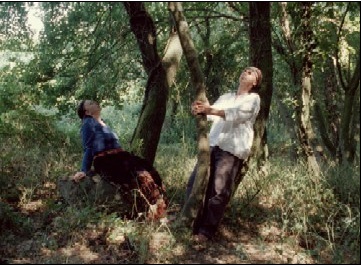
On December 5,I didn't want to believe this is their final feature film,but...Straub=Huillet's"Quei Loro Incontri",it's an incredible film, the most Renoirien(I remenber especially "The River"),all elements of this film are dazzlingly sensual.Sunlight,mountain,forest,valley,earth shining brightly,the white surface rock,and sounds of wind through these places,birds'warble...and actors.The theater of Athenee Francais Cultural Center(130 seats) was nearly filled to capacity. I heard screening on Saturday(December 9) was full to the doors.
Such beautiful and colourful all explain why Straubs shot this film.Love for the earth.The five acts from Cesare Pavese's Dialogue con Leuco, tells Gods'despair,grief for human being's dwarfishness,stupidty...but audiovisually here the obscure world overpoweringly emerges. The first act starts from the recitation of a man and a woman that are turning back to the camera and stand up in the top of a mountain and the blue sky spread out.In the second act, wonderful wind enchants us and shakes the shine on the tree leakage day that pours down over actors who sit opposite on trees in the forest. In the third act,the camera looks down at actors who stand in a row in the bottom of a ravine,and their voices which mixed with river sounds fill a green space and capture us eternally. In the fourth act,a woman who stands by a tree and a man who sits down, and the sunshin which pours down over the surface of the skin with a yellow hill that becomes a stage, are sensual surprisingly. The fifth act changes radically. Solemn reading of men of the hunter who obtains the sporting gun sounds against the background of land on a white rock surface. Hunter's saying at the end "Quei loro incontri", and the image indicates people's life,and voices... Beethoven is lightly unexpectedly heard.
Needless to say, a film of Straub=Huillet is a documentary of "incontri(meetings)". Meetings between nature changed hour by hour and a play practiced for one year for performance in the small theater in about 200 seats, which was built in 1841.Straubs dare to jeopardize "perfection" for the "meetings". Each shot which is made rhythmically severely and continuously,has the cutting plane of light and the sound, and the structure of the film by montage became more visible.They appear to sacrifice their fiction. However, what wonderful moments these "meetings" are! There is a variation of an individual sound in all individual spaces. For instance, the sound is different when a wind blows to the valley from when it blows to the forest. In addition, when the camera approaches the actor the sound which was picked up by the microphone changes along with it. It's an impact of the unexpected combinations that is sure to exist only in Straub=Huillet's films. Once Daniele Huillet said, 'When the angle changes, the sound changes, too. It is realism.' Of course it is familiar to their funs as a brechtien effect,and functions in a film of Straub=Huillet as an educational device of audio-visual to viewer.However in this 'Incontri', it serves these sensual meetings of all elements and the moments much more than other their films."Quei Loro Incontri"is the richest film of this year.

In December I often went to the retrospective of Mizoguchi and Garrel,and was impressed with their common courage and rashness of early works.The movement of camera in the scene of a prison under ground in Garrel's "Le lit de la vierge" is as imperfect and risky as the movement of camera in the scene of a Shinto shrine in Mizoguchi's "Orizuru Osen"("The Downfall of Osen"),and both of them excited me.It has been very difficult to find this "risky shot" among young japanese director's films since Shinji Somai's death.But Teiichi Hori's second film, "KUSAMURA" touched me."KUSAMURA" was made as a "pink film",is a suburban melodrama, and has atmosphere of film-noir.This film has no long take shot, but has superb mis-en-scene and risky shots.For example when the protagonist of a married woman and a young man who is working of garbage collection make love each other during the husband's absence,the man presses the woman's body against the wall and moves forward rapidly and the camera follows keeping a certain distance. When the marrige woman talks with her husband's lover in a car,Hori shot only close-ups of two women. He keeps this "a certain distance" again and succeeded this shot-reverse-shot scene keeps full of tension. The appearance of the husband(a back shot)is also wonderful. Hori must be the most talented japanese director for these years.

I also went to "AA-Signature Aquirax",Shinji Aoyama's monumental film about Akira Aida(1946~1978),who was one of the most influencial japanese critic of 60~70s,about Rock,Jazz,free improvised music.Aida was also a producer and a festival organizer.For examle He invited guitarist Derek Bailey,drummer Milford Graves and saxophonist Steve Lacy to Japan and made records. This 7 hours and a half(6 chapters) film is consist of interviews and four solo live performances by Keiji Haino(guitar) and Yoshihide Otomo(turntable)-that suggests "AA" is a sequel to "Eli Eli Lema Sabachthani?". Musicians and critics(all japanese) who were personally related to him or influenced by Aida's texts, talk about his activities,personality,idea(Aida was influenced by Rudolf Steiner),etc..But at the same time they talk about themselves because they talk about their (affirmative or negative)reaction to Aida,and about the history of japanese music which is influenced by western music,and about political situation of 1960~70s in Japan.
Aoyama left the work of interviewer to Toshiharu Osato(critic of music),and preparing questions to students of the Film School of Tokyo.It's like "Rivettien process" because Aoyama probably knows "centralization of power" is the most important problem of all japanese systems(for Aida,too). Then where is Aoyama's signature? I was impressed with Aoyama's respect for "sound".In first live scene of Haino, Aoyama shot him with zigzag moving forward from high angle to low angle.And after performance Haino left, Aoyama left Haino's footsteps in this long one shot. In chapter 5, Otomo is talking about John Cage, modern music, possibility of expansion of music,and says even computer noise can be accepted by audience as music.While Otomo is talking,crows are cawing outside.And soon after that critic Atsushi Sasaki also says the sound of air-conditioner can be "music",but before Sasaki says this film succeded to let viewers listen to footsteps and cry of crows as "music". Aoyama realized what Otomo and Sasaki are talking about.Because of such a delicate sound work I think "AA"is the best japanese film of 2006.
(2006.12.28)
©Akasaka Daisuke